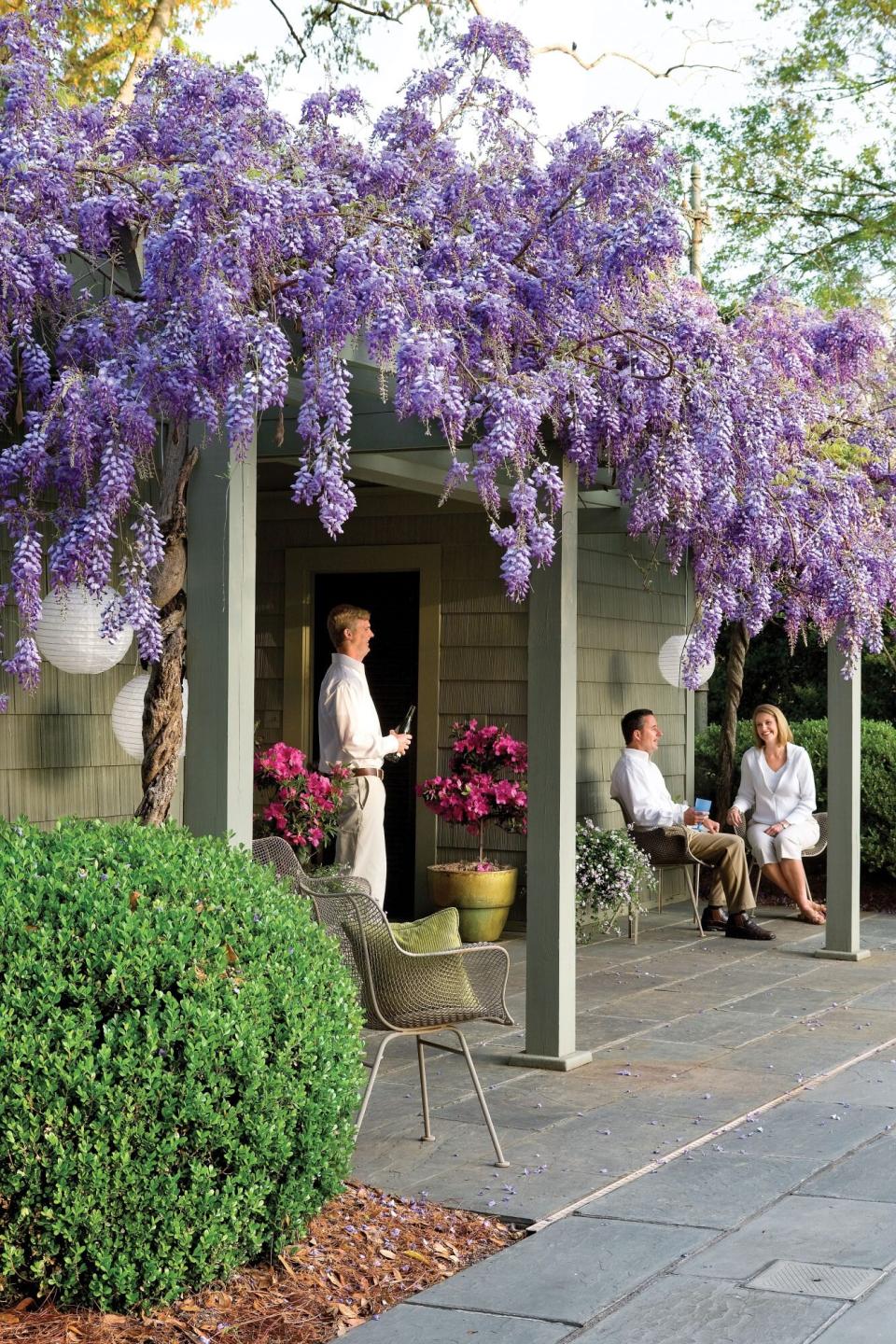How To Grow and Tame Wisteria So It Doesn't Take Over Your Yard

TABLE OF CONTENTS
On This Page
Know Your Wisterias
Wisteria Growing Basics
How To Train a Wisteria Tree
How To Train Wisteria to Frame a Porch
Wisteria Needs Good Support
It is one of the first harbingers of spring and warmer weather. Encouraged by the daffodils, which have already braved the cold weather and opened their faces to the sun, clusters of purple and pink wisteria blooms can be seen suspended on vines, trailing in and out of the still barren tree branches and along fence lines. In a matter of days the entire wisteria vine will be a riot of bright green leaves and fragrant, opulent flowers. Just like gardenias and azaleas, wisteria is an essential member of the Southern garden. But unlike the aforementioned plants, wisteria wears out its welcome rather quickly. The beautiful and fragrant blooms fade quickly and you are left with an ambitious, aggressive vine that can quickly consume trees, arbors, and porches. The gorgeous, show-stopping wisteria can suddenly become an invasive nuisance when it is neglected and untrained, so here are some tips on choosing the right variety for your use and how to keep it from overwhelming your property.
Know Your Wisterias
Two of the more popular species of wisteria, Japanese wisteria and Chinese wisteria, both feature overhanging vines with clusters of fragrant blue, purple, pink, or white pea-shaped flowers in early spring. They grow fast, and if not controlled by regular pruning, quickly consume whatever is in their path. Sounds a lot like kudzu. Instead of spending the season running around your yard with a pair of clippers, you may want to try 'Amethyst Falls,' a form of our American native wisteria. This is a strong grower, reaching 30 feet or more, but is not invasive like its Asian cousins and is ideally suited for growing in containers, training up a trellis, or even as a small free-standing tree. 'Amethyst Falls' will bloom in its first season, and the blooms arrive about two weeks later than blooms from the Asian wisteria, so late-winter frosts seldom affect flowering. Need more reasons to love this wisteria? It is deer resistant and drought tolerant.
Wisteria Growing Basics
Ready to plant a new wisteria vine? Cut the bottom from a large plastic tree container, dig a hole big enough for the container and place it in the ground, then plant your wisteria directly in it. The container walls will help control lateral root growth. Wisteria is not fussy about soil but needs good drainage, and it generally doesn't need fertilizer. Most of the maintenance of these climbers comes from training and pruning them.
The sight of colorful wisteria weeping gracefully down and across a porch is an iconic picture of a Southern garden, but the reality is far different than the romance. This beautiful image requires some hard-core maintenance to keep the vines from overtaking your gutters and drain spouts.
How To Train a Wisteria Tree
You can purchase an already-trained wisteria tree, or you can train your own. Here is how: Remove all but one main stem and stake this one securely. Using plastic tape, tie the stem to the stake at intervals. When the plant has reached the height at which you wish the head to form, pinch or prune out the tip to force branching. Shorten the branches to beef them up, pinch back long streamers, and rub off all buds that form below the head.
How To Train Wisteria to Frame a Porch
To safely train wisteria along the top of a ground-floor porch, heed this advice from the Grumpy Gardner: Run a metal pole from one porch post to another about 18 inches below the crossbeam. Let the vine's branches and runners twine only around the pole. Once flowering finishes, you'll need to prune the vine regularly if you want to maintain clear sightlines from your porch.
Wisteria Needs Good Support
The twining, woody vines of wisteria will overpower flimsy wooden arbors, so choose one with a sturdy metal frame. Let the vine climb a corner post to the top, and tie it to the arbor. Train it so most of its branches and runners lie atop the arbor and wrap around themselves rather than the posts and rafters, or simply train this plant to run up a brick wall.
Wisteria's blooms drop within days, so stop what you are doing and take in the show.

